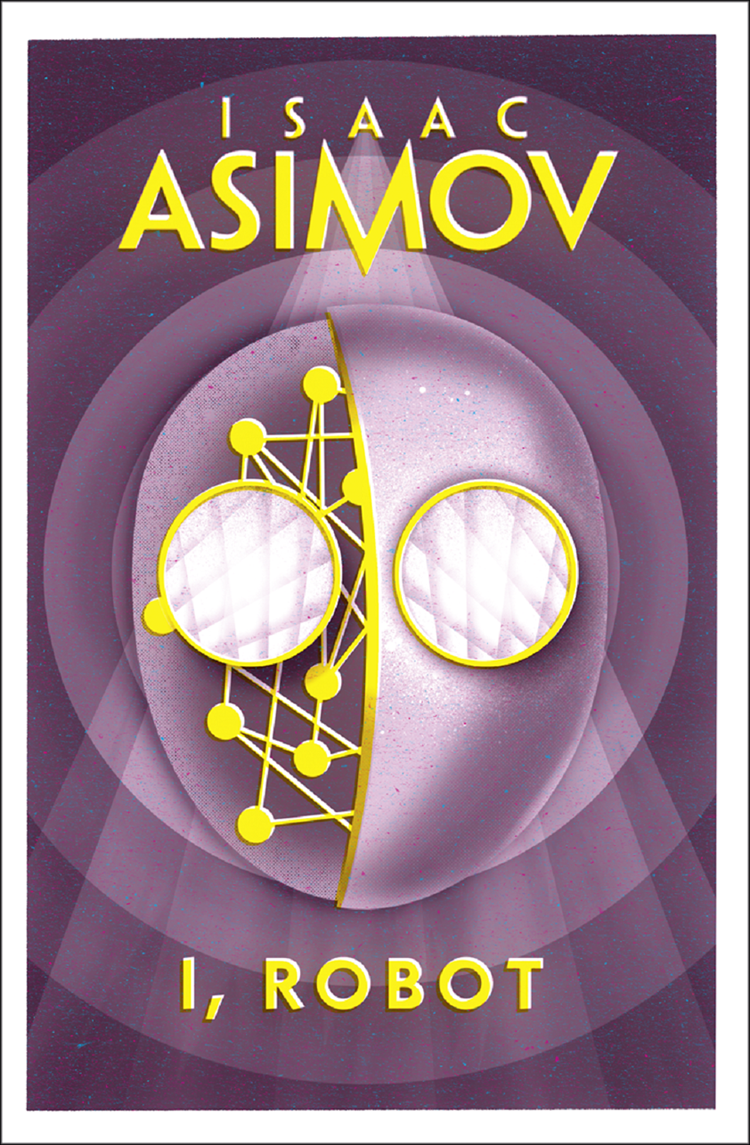d="ud20972e5-eb0e-58c7-b11d-719391e8910d">
HarperVoyager
An imprint of HarperCollinsPublishers Ltd
1 London Bridge Street
London SE1 9GF
First published in Great Britain by Dobson Books Ltd 1967
Copyright © Isaac Asimov 1950, 1977
Cover design and illustration by Mike Topping © HarperCollinsPublishers Ltd 2018
Isaac Asimov asserts the moral right to be identified as the author of this work.
A catalogue copy of this book is available from the British Library.
This novel is entirely a work of fiction. The names, characters and incidents portrayed in it are the work of the author’s imagination. Any resemblance to actual persons, living or dead, events or localities is entirely coincidental.
All rights reserved under International and Pan-American Copyright Conventions. By payment of the required fees, you have been granted the non-exclusive, non-transferable right to access and read the text of this e-book on screen. No part of this text may be reproduced, transmitted, down-loaded, decompiled, reverse engineered, or stored in or introduced into any information storage and retrieval system, in any form or by any means, whether electronic or mechanical, now known or hereinafter invented, without the express written permission of HarperCollins.
Source ISBN: 9780008279554
Ebook Edition © March 2018 ISBN: 9780007369355
Version: 2018-04-17
Contents
Copyright
Introduction
1. Robbie
2. Runaround
3. Reason
4. Catch That Rabbit
5. Liar!
6. Little Lost Robot
7. Escape!
8. Evidence
9. The Evitable Conflict
About the Author
By the Same Author
About the Publisher
The Three Laws of Robotics
1 – A robot may not injure a human being, or, through inaction, allow a human being to come to harm.
2 – A robot must obey the orders given it by human beings except where such orders would conflict with the First Law.
3 – A robot must protect its own existence as long as such protection does not conflict with the First or Second Law.
Handbook of Robotics, 56th Edition, 2058 A.D.
I looked at my notes and I didn’t like them. I’d spent three days at US Robots and might as well have spent them at home with the Encyclopedia Tellurica.
Susan Calvin had been born in the year 1982, they said, which made her seventy-five now. Everyone knew that. Appropriately enough, US Robots and Mechanical Men, Inc. was seventy-five also, since it had been in the year of Dr Calvin’s birth that Lawrence Robertson had first taken out incorporation papers for what eventually became the strangest industrial giant in man’s history. Well, everyone knew that, too.
At the age of twenty, Susan Calvin had been part of the particular Psycho-Math seminar at which Dr Alfred Lanning of US Robots had demonstrated the first mobile robot to be equipped with a voice. It was a large, clumsy unbeautiful robot, smelling of machine-oil and destined for the projected mines on Mercury. —But it could speak and make sense.
Susan said nothing at that seminar; took no part in the hectic discussion period that followed. She was a frosty girl, plain and colorless, who protected herself against a world she disliked by a mask-like expression and hypertrophy of intellect. But as she watched and listened, she felt the stirrings of a cold enthusiasm.
She obtained her bachelor’s degree at Columbia in 2003 and began graduate work in cybernetics.
All that had been done in the mid-twentieth century on ‘calculating machines’ had been upset by Robertson and his positronic brain-paths. The miles of relays and photocells had given way to the spongy globe of plantinumiridium about the size of a human brain.
She learned to calculate the parameters necessary to fix the possible variables within the ‘positronic brain’, to construct ‘brains’ on paper such that the responses to given stimuli could be accurately predicted.
In 2008, she obtained her Ph.D. and joined United States Robots as a ‘Robopsychologist’, becoming the first great practitioner of a new science. Lawrence Robertson was still president of the corporation; Alfred Lanning had become director of research.
For fifty years, she watched the direction of human progress change – and leap ahead.
Now she was retiring – as much as she ever could. At least, she was allowing someone else’s name to be inset upon the door of her old office.
That, essentially, was what I had. I had a long list of her published papers, of the patents in her name; I had the chronological details of her promotions— In short I had her professional ‘vita’ in full detail.
But that wasn’t what I wanted.
I needed more than that for my feature articles for Interplanetary Press. Much more.
I told her so.
‘Dr Calvin,’ I said, as lushly as possible, ‘in the mind of the public you and US Robots are identical. Your retirement will end an era and—’
‘You want the human-interest angle?’ She didn’t smile at me. I don’t think she ever smiles. But her eyes were sharp, though not angry. I felt her glance slide through me and out my occiput and I knew that I was uncommonly transparent to her; that everybody was.
But I said, ‘That’s right.’
‘Human interest out of Robots? A contradiction.’
‘No, doctor. Out of you.’
‘Well, I’ve been called a robot myself. Surely, they’ve told you I’m not human.’
They had, but there was no point in saying so.
She got up from her chair. She wasn’t tall and she looked frail.
